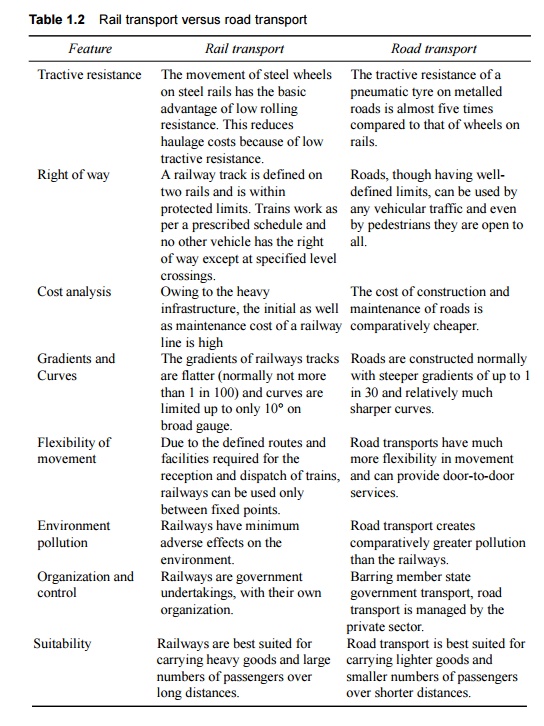Chapter: Civil : Railway Airport Harbour Engineering : Railway Engineering : History and General Features of Indian Railways
Different Modes of Transport
Different Modes of Transport
Our environment consists of land, air, and water.
These media have provided scope for three modes of transport-land transport,
air transport and water transport. Rail transport and road transport are the
two components of land transport. Each mode of transport, depending upon its
various characteristics, has intrinsic strengths and weaknesses and can be best
used for a particular type of traffic as given below.
Rail transport Owing
to the heavy expenditure on the basic infrastructure required, rail
transport is best suited for carrying bulk commodities and a large number of
passengers over long distances.
Road transport Owing
to flexibility of operation and the ability to provide door-to-door service,
road transport is ideally suited for carrying light commodities and a small
number of passengers over short distances.
Air
transport Owing to the heavy expenditure on the
sophisticated equipment required and the high fuel costs, air
transport is better suited for carrying passengers or goods that have to reach
their destinations in a very short period of time.
Water transport Owing
to low cost of infrastructure and relatively slow speeds, water
transport is best suited for carrying heavy and bulky goods over long
distances, provided there is no consideration of the time factor.
1 Railway as a Mode of Land Transport
There
are two modes of land transport, railways and roads, and each has its relative
advantages and disadvantages. These have been summarized in Table 1.2.

2 Role of Indian Railways
Since its inception, Indian Railways has
successfully played the role of the prime carrier of goods and passengers in
the Indian subcontinent. As the principal constituent of the nation's transport
infrastructure, the Railways has an important role to play.
(a) It
helps integrate fragmented markets and thereby stimulate the emergence of a
modern market economy.
(b) It
connects industrial production centres with markets as well as sources of raw
material and thereby facilitates industrial development.
(c) It
links agricultural production centres with distant markets as well as sources
of essential inputs, thereby promoting rapid agricultural growth.
(d) It
provides rapid, reliable, and cost-effective bulk transportation to the energy
sector; for example, to move coal from the coalfield to power plants and
petroleum products from refineries to consumption centres.
(e) It
links people with places, enabling large-scale, rapid, and low-cost movement of
people across the length and breadth of the country.
(f) In
the process, Indian Railways has become a symbol of national integration and a
strategic instrument for enhancing our defence preparedness.
Related Topics